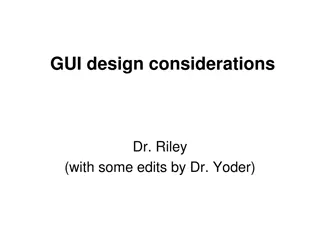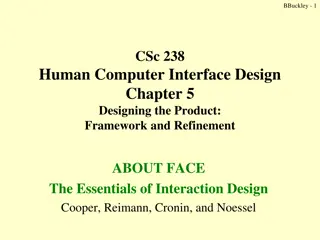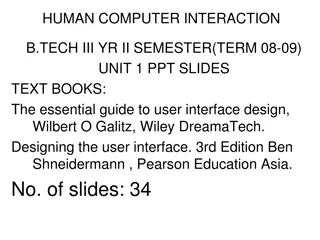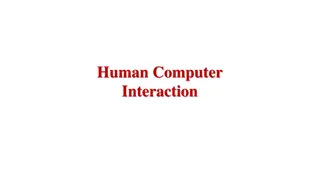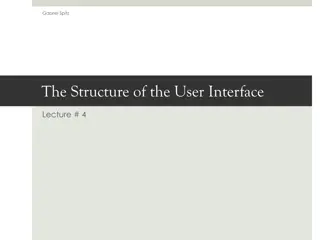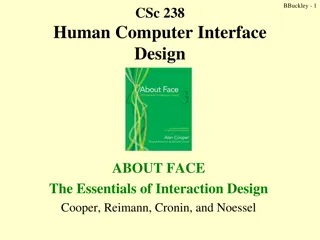User Interface Design Principles Overview
This article delves into various aspects of User Interface Design (UID), covering topics such as UID issues, multidisciplinary domains, adapting UID to different contexts, and crucial design principles including user familiarity, minimal surprise, consistency, and recoverability. The content emphasizes the importance of user-centric design approaches for creating effective and efficient interfaces.
Download Presentation

Please find below an Image/Link to download the presentation.
The content on the website is provided AS IS for your information and personal use only. It may not be sold, licensed, or shared on other websites without obtaining consent from the author.If you encounter any issues during the download, it is possible that the publisher has removed the file from their server.
You are allowed to download the files provided on this website for personal or commercial use, subject to the condition that they are used lawfully. All files are the property of their respective owners.
The content on the website is provided AS IS for your information and personal use only. It may not be sold, licensed, or shared on other websites without obtaining consent from the author.
E N D
Presentation Transcript
INTRODUCTION TO USER INTERFACE DESIGN P A R T 3 DR JIHANE BOULAHIA DR SMIRANI LASSAAD
UID ISSUES Increasing population of computer system users Growing power of computers New interaction devices Explosion of multimedia: sound, image, video etc. Development of computer networks DIGITAL CONVERGENCE
UID Multidisciplinary domain Computer science Artifial Intelligence Programming Speech synthesis and recognition Natural Langage Picture System Cognitive ergonomics, software ergonomics Communication, graphics, audiovisual Educational sciences, didactics Cognitive psychology Anthropology, sociology, philosophy, linguistics
ADAPT THE UID To the context general public (offer an immediate grip) leisure (make the product attractive) industry (increase productivity) critical systems (ensure zero risk) To the characteristics of the task - repetitive, regular, occasional, sensitive to changes in constrained by time ... the environment, To the Technical constraints Platform, memory size, screen, sensors, effectors old code reuse
DESIGN PRINCIPLES User familiarity The interface should be based on user-oriented terms and concepts rather than computer concepts. For example, an office system should use concepts such as letters, documents, folders etc. rather than directories, file identifiers, etc.
DESIGN PRINCIPLES Minimal surprise If a command operates in a known way, the user should be able to predict the operation of comparable commands
DESIGN PRINCIPLES Consistency The system should display an appropriate level of consistency. Commands and menus should have the same format, command punctuation should be similar, etc.
DESIGN PRINCIPLES Recoverability The system should provide some resilience to user errors and allow the user to recover from errors. This might include an undo facility, confirmation of destructive actions, 'soft' deletes, etc.
DESIGN PRINCIPLES User guidance Some user guidance such as help systems, on-line manuals, etc. should be supplied
DESIGN PRINCIPLES User diversity Interaction facilities for different types of user should be supported. For example, some users have seeing difficulties and so larger text should be available
USER-SYSTEM INTERACTION Two problems must be addressed in interactive systems design How should information from the user be provided to the computer system? How should information from the computer system be presented to the user?
USER-SYSTEM INTERACTION User interaction and information presentation may be integrated through a coherent framework such as a user interface metaphor





